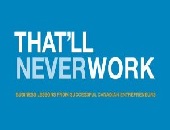It’s a book that invites browsing. Open it to a random page and immerse yourself in one small business story. Riffle to a spot twenty pages earlier and taste another. It’s a book that can be enjoyed by someone on the go, someone only has time for, say, a ten minute skim before the next appointment.
After a few chapters (sampled in non-linear fashion) I was reminded of Grimm’s Tales. The archetypes of the business world, in particular the entrepreneurial world, are practically the same. The plucky maiden, the resilient hero, the marrow-sucking ogre, the chastened warrior: they are present in modified forms but just as identifiable. There are, too, the set pieces: the battle with the dragon/wolf, the enormous setback, the rallying of doubtful troops, and the over-arching challenge: “That’ll Never Work.” I felt swept into the stories of these people.
The resilient hero – “It wasn’t the first time I’d had to stand by and watch as a fire destroyed my business. In 1986… I was jolted awake by a cottager who called to tell me our shop was on fire. My dad’s home was attached to the shop … he woke up, got in his wheelchair, … and literally wheeled his chair a quarter mile to the nearest neighbour. It was traumatic. The shop was destroyed, although we were able to save and eventually rebuild his house.” (p. 50) Jim Deslaurier, Deslaurier Custom Cabinet
The marrow-sucking ogre – “[Philosopher Marcus] Aurelius … said, ‘When you wake up, you must expect to be greeted each day with interference, ingratitude, insolence, disloyalty, ill-will and selfishness—now lead!’ I feel this is critical for an entrepreneur to hear, since some people think everyone else is supposed to like what they do.” (p. 41) Barb Stegeman, The 7 Virtues Communications Group
The chastened warrior – “But I had to stand on the precipice. If we hadn’t faced bankruptcy I think somehow, some way, I would have rationalized bobbing along, not really making a good living, not really performing well as a company. Somehow that would have continued to be acceptable … But there was no choice.” – (p.138) – Jory Lamb VistaVu Solutions
Doing battle with the wolf – “… I exceeded my quota by 300 percent, marched into the president’s office and demanded the money I was owed, along with a promotion. … His response was: ‘Take a look around and tell me if you see any other women in management at this company.’ … I asked him if he wasn’t afraid I would take legal action for discrimination and breach of contract. He smiled and calmly told me he was one month away from retirement. ‘Sweetheart,’ he said smugly, ‘do whatever the hell you want because I won’t be around to deal with it.’ …” (p. 73) – Gayle Robin, Strategic Ampersand
Rallying the troops – “Another time… we renovated a store…. We could only have the store closed for 10 days. … My brother Glen must have spent 200 of the 240 hours at the store keeping ahead of, or motivating, the contractors. It seemed everything that could happen did, including one of the contractors actually cutting through the main power supply with a saw. …[It] shut down the whole building, including the vault in the Royal Bank sharing the first floor … it was left to our staff to visit the bank and make sure everyone there knew we were doing what we could to fix the problem. When the store reopened after 10 days, we invited everyone from the bank and all the other neighbours…” (p. 172) – Ray Price – Sunterra Market
Rising to a challenge – “[a business mentor] kept pushing me on my financial targets … I felt patronized, like she didn’t really believe in my business. … Plucking a number out of thin air, I told her my new consulting business, Pelorus Learning, would do £150,000 in the first year. She looked at me as if to say, “Are you on drugs?” The moral of the story is she didn’t know me. She was simply acting on what she knew of the environment. I, on the other hand, had been given a challenge. … I’m happy to report that not only did I meet Pelorus Learning’s initial target, I exceeded it by 33 percent.” (p. 144) Natalie Macaulay, Emerge Learning.
There is no law that says a committee can’t write a book, especially if it’s a collection of related pieces, but if you look at the list of the top business books (curated at sites such as The 100 Best Business Books of All Time or Forbes’ list The 20 Most Influential Business Books, or Harvey Schachter’s list), they have one, two, or at most three authors.
How well can a faceless committee perform by comparison? KPMG Enterprise should reconsider their position on this matter for volume two (assuming there will be a volume two produced from the influx of new material invited by the book’s web site). If the Encyclopedia Britannica could allow its “brand” to be dented by the inclusion of the names of individuals of contributed articles, then surely KPMG Enterprise can allow names of individuals for each profile and/or the name of the editor who finally, magically, weaves it all together. Perhaps it is Dennis Fortnum, who has written the foreword.
Would it kill them to provide an index? Guidelines for acquisitions at most public libraries stipulate that quality non-fiction books should include an index. Lack of an index is frustrating for readers who recall a certain passage (“something about a wheelchair in a fire…”) and want to look it up efficiently.
Apart from these detractions—lack of named authors, and lack of an index—this book is a fascinating read of “life in the trenches” for anyone who has ever entertained the thought of starting a business—or who has done so and would like to compare “war stories.” ª
For more information on this book, visit its web site at: http://www.thatllneverwork.ca
The list of entrepreneurs profiled is at: http://www.thatllneverwork.ca/entrepeneurs.php
To contribute your own story on-line, visit: http://www.thatllneverwork.ca/yourstory.php The list of entrepreneurs profiled is at: http://www.thatllneverwork.ca/entrepeneurs.php


